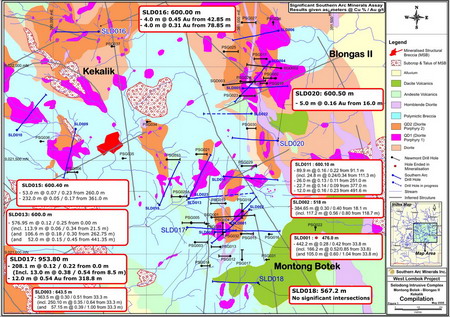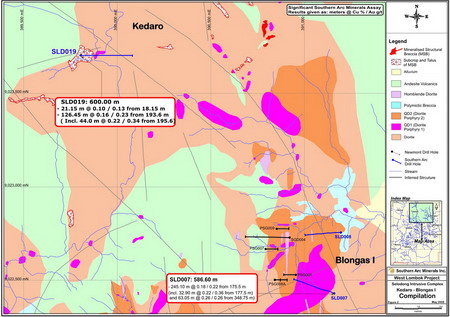Southern Arc Releases Drill Results from Montong Botek, Kedaro and Kekalik Target Areas
Montong Botek Porphyry Target
Drill hole SLD017 was the first of two planned deep holes (approximately 1000 metres) at Montong Botek to test the conventional vertical "beer bottle shape” concept characterized by an increase in diameter and grade of porphyry Cu-Au mineralization with depth, Figure 1. Previous drilling (SLD003) along the same east-west section returned 363.50 metres at 0.30% Cu and 0.51 g/t Au from 33.30 metres to 396.80 metres. Analytical results of SLD017 reported a shallow intersection of:
208.10 m at 0.12% Cu and 0.22 g/t Au from 0.00 m to 208.10 mThe lack of continuity of mineralization at depth suggests mineralization is plunging in another orientation besides vertical. An inferred northerly plunge of mineralization is supported by Cu-Au intercepts in holes SLD001, 002, 011, 013 and SGD001. This concept is now being tested as Drill Rig No. 3, with capability of drilling 1,100 metres, is now drilling hole SLD023 150 metres to the north of SLD017.
(including: 13.00 m at 0.38% Cu and 0.54 g/t Au from 8.50 m to 21.50 m)
SLD017 was drilled eastward at an inclination of -73 degrees to a depth of 953.8 m. From surface to 247 metres, breccia comprising variably mineralized (QD1) and altered clasts of diorite were logged. From 247 metres to the end of the hole a sequence of altered volcanic and volcanic-derived sediments were encountered, which were cross-cut by post-mineralization diorite dykes at 625.0 and 663.0 metres.
SLD018 and SLD020 were drilled to define the south and north shallow extensions of the Montong Botek porphyry, Figure 1. Drill Rig No. 1 drilled the holes to approximately 450 metres vertical depth and targeted shallow to medium extensions of anomalous Cu-Au intersections identified in previous Newmont and later SA drill holes. No significant intersections were reported from either hole.
Both SLD018 and SLD020 were drilled westward at an inclination of -65 degrees to a depth of 567.2 and 600.50 metres respectively. Phyllic and propylitic altered diorite and porphyry equivalents, along with polymictic breccias and volcanics were intersected in both drill holes.
Kedaro Porphyry Target
SLD019 was drilled in the centre of the Kedaro target, Figure 2. The first hole into the Kedaro target has successfully intersected Cu and Au mineralized QD1, the diorite phase analogous to high-grade Cu-Au mineralization already drilled at the Montong Botek and Blongas II targets, 1.5 km to the southeast. More detailed surface mapping will be undertaken to establish potentially larger and better mineralized QD1 extensions at Kedaro.
SLD019 was drilled based upon coincident magnetic anomalism associated with secondary magnetite alteration, elevated surface Cu-Au-Mo geochemistry and associated intense fracturing and porphyry vein stockworks. Analytical results reported a moderate intersection of:
| 126.45 m at 0.16% Cu and 0.23 g/t Au from 193.60 m to 320.05 m | ||
| (including: 44.00 m at 0.22% Cu and 0.34 g/t Au from 195.60 m to 239.60 m) | ||
SLD019 was drilled westward at an inclination of -65 degrees to a length of 600.0 metres. Several phases of variably altered and locally mineralized diorite were logged from surface to a depth of 578 metres. The mineralized interval from 193.6 to 320.1 metres corresponds with variable density quartz-stockwork ± chalcopyrite hosted within intrusive quartz diorite (QD1). Phyllic altered volcanics were logged from 578 metres to the end of the hole.
Kekalik Porphyry Target
SLD016 was collared 120 metres northwest of the historic Newmont drill hole PSG037 (North Kekalik target) to test moderate density porphyry quartz stockwork hosted in magnetite+chlorite±tourmaline altered diorite intrusives, coincident with a 200 x 350 metre ovoid magnetic high. Aside from narrow gold intercepts (maximum 4.0 metres at 0.45 g/t Au from 42.85 to 46.85 metres) relating to narrow quartz-sulfide veins, no other significant intersections were reported.
Current Drilling Activity
On-going drilling continues to test lateral and depth extensions of Au-Cu mineralization at Montong Botek, along with peripheral targets including Kedaro and Lapangan Geres. Three drilling rigs are concurrently in operation at the Selodong Prospect. Drill Rig No. 1 and the larger deep drill (Drill Rig No. 3) are focused on testing potentially mineralized lateral and depth extensions of Montong Botek, Blongas II and Blongas I, while Drill Rig No. 2 is currently undertaking an evaluation of the Lapangan Geres target, the most northerly of the 15 Selodong Intrusive Complex porphyry Cu-Au targets.
- Drill Rig No. 1, with a capacity of 600 metres, is focused on testing the lateral extensions of Montong Botek, Blongas II and a Blongas I to medium depth. Drill Rig No. 1 is currently drilling hole SLD022, approximately 210 metres northwest of SLD020 to test a southern extension of Blongas II. Once this hole is completed Drill Rig No. 1 will move to historical drill site PSG034 (635 m west of SLD022) to test potential west-northwest extensions of Montong Botek and Blongas II porphyry Cu - Au mineralization.
- Drill Rig No. 2, also capable of 600 metres, will continue to drill test the remaining SIC Cu-Au porphyry targets. Drill Rig No. 2 is currently nearing completion of hole SLD021, one of four planned drill holes at the Lapangan Geres target. At Lapangan Geres, surface mapping has identified a N-S structural corridor of porphyry copper-gold mineralization, at least 600+ metres in length and 300 metres in width. Surface mapping is on-going along the strike length of the structural corridor.
- Drill Rig No. 3, with a capacity to reach a depth of 1100 metres, is currently drilling the second deep hole at Montong Botek, SLD023.
Qualified Person and Quality Control and Assurance
The information in this release has been compiled under the supervision of Southern Arc's Vice President of Exploration Hamish Campbell B.Sc.Geology, MAusIMM. Mr. Campbell has over 23 years of international mineral exploration experience including 21 years in Indonesia during which he has held such positions as Exploration Manager, Senior Geologist and Consulting Geologist. Mr. Campbell has sufficient experience relevant to the style of mineralization under consideration and qualifies as a Qualified Person as defined in terms of NI 43-101.
All assaying of samples was undertaken by the ITS laboratory in Jakarta. ITS is one of the world's largest product and commodity testing, inspection and certification organizations. The Jakarta laboratory is ISO 17025 accredited and employs a Laboratory Information Management System (LIMS) for sample tracking, quality control and reporting. In addition to the laboratory's quality assurance program, the Company employs its own comprehensive quality assurance/control program including blanks and standards, along with reassays of selective drill pulps by independent industry-accredited laboratories.
On behalf of the Board of
Southern Arc Minerals Inc.
"John Proust”
President and CEO
For more information please contact:
Southern Arc Minerals Inc.
c/o John G. Proust, CEO
Telephone: (604) 676-5241 Fax: (604) 676-5246
Email: This email address is being protected from spambots. You need JavaScript enabled to view it.
Website: http://southernarcminerals.com/
"The TSX Venture Exchange does not accept responsibility for the adequacy or accuracy of this release”




